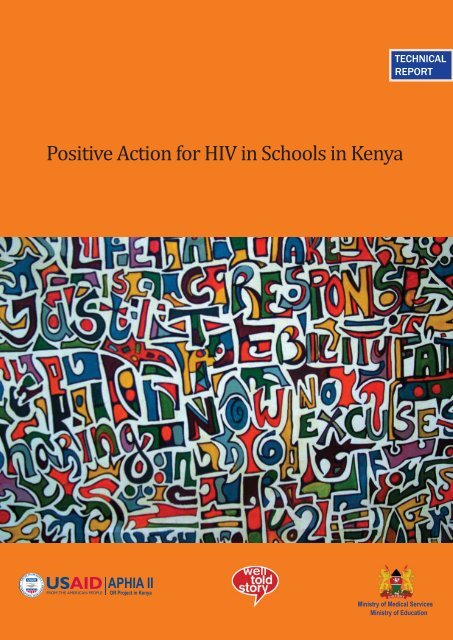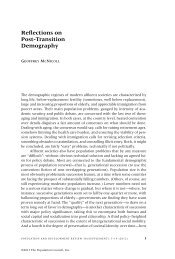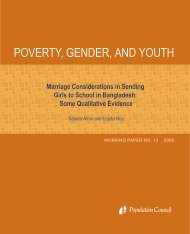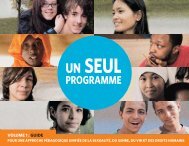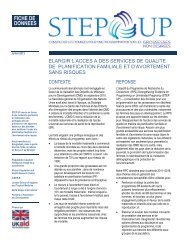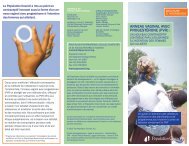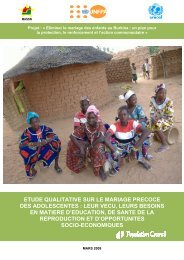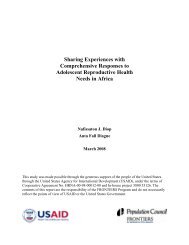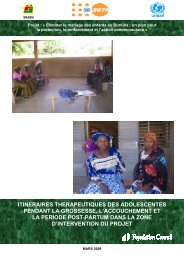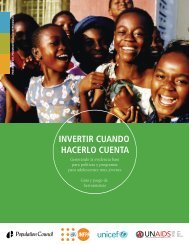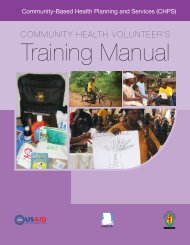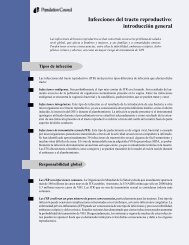Positive Action for HIV in Schools in Kenya - Population Council
Positive Action for HIV in Schools in Kenya - Population Council
Positive Action for HIV in Schools in Kenya - Population Council
Create successful ePaper yourself
Turn your PDF publications into a flip-book with our unique Google optimized e-Paper software.
<strong>Positive</strong> <strong>Action</strong> <strong>for</strong> <strong>HIV</strong> <strong>in</strong> <strong>Schools</strong> <strong>in</strong> <strong>Kenya</strong><br />
APHIA II<br />
OR Project <strong>in</strong> <strong>Kenya</strong><br />
TECHNICAL<br />
REPORT<br />
M<strong>in</strong>istry of Medical Services<br />
M<strong>in</strong>istry of Education
<strong>Positive</strong> <strong>Action</strong> <strong>for</strong> <strong>HIV</strong> <strong>in</strong> <strong>Schools</strong> <strong>in</strong> <strong>Kenya</strong><br />
APHIA II Operations Research Project, <strong>Population</strong> <strong>Council</strong><br />
Francis Obare, Harriet Birungi, Monica Wanjiru, Sheila Bayley<br />
M<strong>in</strong>istry of Education<br />
John Kiunjuri, Mary Omondi<br />
Well Told Story<br />
Rob Burnet, Bridget Deacon<br />
National AIDS and STI Control Programme<br />
Christ<strong>in</strong>e Awuor<br />
March 2012
The <strong>Population</strong> <strong>Council</strong>, Inc. One Dag Hammarskjold Plaza, New York,<br />
New York, 10017.<br />
© 2012 The <strong>Population</strong> <strong>Council</strong>, Inc.<br />
The <strong>Population</strong> <strong>Council</strong> confronts critical health and development<br />
issues—from stopp<strong>in</strong>g the spread of <strong>HIV</strong> to improv<strong>in</strong>g reproductive<br />
health and ensur<strong>in</strong>g that young people lead full and productive lives.<br />
Through biomedical, social science, and public health research <strong>in</strong> 50<br />
countries, we work with our partners to deliver solutions that lead to<br />
more effective policies, programs, and technologies that improve lives<br />
around the world. Established <strong>in</strong> 1952 and headquartered <strong>in</strong> New York,<br />
the <strong>Council</strong> is a nongovernmental, nonprofit organization governed by an<br />
<strong>in</strong>ternational board of trustees.<br />
www.popcouncil.org<br />
This publication has been made possible with the generous support of the<br />
American people through USAID/<strong>Kenya</strong>, under the APHIA II<br />
Operations Research Project, a cooperative agreement No. 623-A-00-09-<br />
00001-00 between the <strong>Kenya</strong> Mission and the <strong>Population</strong> <strong>Council</strong>. The<br />
op<strong>in</strong>ions expressed here<strong>in</strong> are those of the authors and do not necessarily<br />
reflect the views of USAID.<br />
Cover pa<strong>in</strong>t<strong>in</strong>g: © 2009, Eirik Jarl Trondsen<br />
Eirik Jarl Trondsen was born <strong>in</strong> Oslo, Norway, studied <strong>in</strong> Uganda, and<br />
worked with art <strong>in</strong> the Kibera slum of Nairobi and currently lives <strong>in</strong><br />
<strong>Kenya</strong>. Contact: ejtconsult@gmail.com. The pa<strong>in</strong>t<strong>in</strong>g on the cover page<br />
signifies the colorful and energetic world. It represents a transition<br />
between <strong>for</strong>m and <strong>for</strong>mless <strong>in</strong>spirations, and <strong>in</strong>cludes shapes and words<br />
of life: <strong>in</strong>tegrity, responsibility, hope, and justice <strong>for</strong> all.<br />
Suggested Citation: Francis Obare, Harriet Birungi, Monica Wanjiru,<br />
Sheila Baiyley, John Kiunjuri, Mary Omondi, Rob Burnet, Bridget<br />
Deacon. 2012. <strong>Positive</strong> <strong>Action</strong> <strong>for</strong> <strong>HIV</strong> <strong>in</strong> <strong>Schools</strong> <strong>in</strong> <strong>Kenya</strong>. APHIA II<br />
OR Project <strong>in</strong> <strong>Kenya</strong>. <strong>Population</strong> <strong>Council</strong>: Nairobi, <strong>Kenya</strong>.<br />
Any part of this publication may be photocopied without permission<br />
from the publisher provided that copies are distributed without charge<br />
and that full source citation is provided. The <strong>Population</strong> <strong>Council</strong> would<br />
appreciate receiv<strong>in</strong>g a copy of any materials <strong>in</strong> which the text is used.
Contents<br />
Acronyms ..................................................................................................................................................... ii<br />
Acknowledgements .................................................................................................................................... iii<br />
Executive Summary ................................................................................................................................... iv<br />
Key f<strong>in</strong>d<strong>in</strong>gs ........................................................................................................................................... iv<br />
Background .................................................................................................................................................. 1<br />
Study objectives ........................................................................................................................................... 2<br />
Methodology ................................................................................................................................................ 2<br />
Study design ............................................................................................................................................ 2<br />
Target population ................................................................................................................................... 2<br />
Intervention activities ............................................................................................................................ 2<br />
Data analysis ............................................................................................................................................ 4<br />
Ethical clearance ..................................................................................................................................... 5<br />
Characteristics of students ......................................................................................................................... 5<br />
Experiences with <strong>in</strong>terventions ................................................................................................................. 5<br />
Need <strong>for</strong> <strong>HIV</strong> and AIDS <strong>in</strong><strong>for</strong>mation ..................................................................................................... 8<br />
Need <strong>for</strong> other sexual and reproductive health <strong>in</strong><strong>for</strong>mation ................................................................ 9<br />
Knowledge about <strong>HIV</strong> and AIDS .......................................................................................................... 10<br />
Communication about <strong>HIV</strong> and AIDS ................................................................................................. 11<br />
Attitudes towards people liv<strong>in</strong>g with <strong>HIV</strong> ............................................................................................ 14<br />
Uptake of <strong>HIV</strong> test<strong>in</strong>g and counsel<strong>in</strong>g .................................................................................................. 16<br />
Sexual behavior ......................................................................................................................................... 18<br />
Discussion and summary of f<strong>in</strong>d<strong>in</strong>gs ..................................................................................................... 19<br />
Challenges and limitations ....................................................................................................................... 21<br />
Conclusion and recommendations ......................................................................................................... 22<br />
References .................................................................................................................................................. 23<br />
i
Acronyms<br />
AIDS Acquired Immunodeficiency Syndrome<br />
APHIA AIDS, <strong>Population</strong> and Health Integrated Assistance<br />
ARV Antiretroviral Drugs<br />
ERC Ethics Review Committee<br />
GNP+ Global Network<strong>in</strong>g of People Liv<strong>in</strong>g with <strong>HIV</strong>/AIDS<br />
<strong>HIV</strong> Human Immunodeficiency Virus<br />
ILO International Labour Organization<br />
IRB Institutional Review Board<br />
KEMRI <strong>Kenya</strong> Medical Research Institute<br />
KNBS <strong>Kenya</strong> National Bureau of Statistics<br />
MOPHS M<strong>in</strong>istry of Public Health and Sanitation<br />
NASCOP National AIDS and STI Control Programme<br />
NCST <strong>Kenya</strong> National <strong>Council</strong> of Science and Technology<br />
OR Operations Research<br />
PHDP <strong>Positive</strong> Health, Dignity and Prevention<br />
PTA Parents-Teachers Association<br />
SNEP Special Needs Education Policy<br />
SRH Sexual and Reproductive Health<br />
STI Sexually Transmitted Infection<br />
UNAIDS Jo<strong>in</strong>t United Nations Programme on <strong>HIV</strong>/AIDS<br />
UNESCO United Nations Educational, Scientific and Cultural Organization<br />
USAID United States Agency <strong>for</strong> International Development<br />
VCT Voluntary Counsel<strong>in</strong>g and Test<strong>in</strong>g<br />
ii
Acknowledgements<br />
This report is based on a study that was funded by the United States Agency <strong>for</strong> International<br />
Development (USAID)/<strong>Kenya</strong> Mission through cooperative agreement 623-A-00-09-00001-00<br />
between the Mission and the <strong>Population</strong> <strong>Council</strong>. The study was implemented by the APHIA II<br />
Operations Research Project <strong>in</strong> collaboration with the AIDS Control Unit <strong>in</strong> the M<strong>in</strong>istry of<br />
Education, Well Told Story, and the National AIDS/STI Control Programme (NASCOP).<br />
The project received logistical guidance and support from the Director of Policy and Plann<strong>in</strong>g <strong>in</strong><br />
the M<strong>in</strong>istry of Education: Mr. Kiragu Magochi; the District Quality Assurance and Standards<br />
Officers: Hellen Bornett, Timothy Ndigutu, Edna Ambassa, Moses Muita, Lydia Muchemi, and<br />
Cecilia Kihembe; the Pr<strong>in</strong>cipals of the participat<strong>in</strong>g schools: Mr. Cleophas Tirop, Mr. Stephen<br />
Njoroge, Mrs. Zuhura Rajab, Mrs. Margret Njaggah, Mrs. Conslata Kimuya, Mr. Maurice<br />
Okumo, Mrs. Emma Odongo, and Mrs. Jael Muriithi; and the Guidance and Counsel<strong>in</strong>g<br />
teachers: Mrs. Anna Mutua, Ms. Damaris, Ingrid Moragwa, Roselyn Watitwa, Mrs. Kimani, Mrs.<br />
Kiragu, Mrs. Mukui, Ms. Ruth Wanjiku, Mrs. Rose Mutonga, Mrs. Vivian Obonyo, Mrs.<br />
Magdal<strong>in</strong>e Obonyo, and Theresia Mumbi. We further acknowledge the <strong>in</strong>valuable cooperation<br />
received from students and teachers <strong>in</strong> general.<br />
The communications materials were developed by Well Told Story. Bridget Deacon created and<br />
developed the content with the assistance of Charles Ouda while Salim Busuru was responsible<br />
<strong>for</strong> design<strong>in</strong>g the communications materials. Anne-Rose Waceke provided adm<strong>in</strong>istrative<br />
support <strong>in</strong>clud<strong>in</strong>g the distribution of the materials to schools and collat<strong>in</strong>g feedback from<br />
students and teachers. Kev<strong>in</strong> Waire and Charles Ouda conducted the eduta<strong>in</strong>ment activities.<br />
Margaret Nz<strong>in</strong>a and Peris Gichanga, the District AIDS and STI Coord<strong>in</strong>ators under the M<strong>in</strong>istry<br />
of Public Health and Sanitation, conducted the health talks. The tra<strong>in</strong><strong>in</strong>g of school-based<br />
caregivers on <strong>HIV</strong> care and support was undertaken by Eunice Okoth, a consultant and expert<br />
on sexual and reproductive health <strong>in</strong>clud<strong>in</strong>g <strong>HIV</strong> and AIDS.<br />
The successful completion of the project was also made possible by a team of research assistants<br />
<strong>in</strong>clud<strong>in</strong>g Christabell Hoka, Brian Solomon, and Daisy Sabwa. The data were entered by Carol<strong>in</strong>e<br />
Apiyo, Florian Lugaliki, David Ochieng’, Irean Wangechi, Boniface Od<strong>in</strong>do, Khadija Ali, Sarah<br />
Omai, and Grace Mwema.<br />
W<strong>in</strong>nie Osulah of the <strong>Population</strong> <strong>Council</strong> provided <strong>in</strong>valuable adm<strong>in</strong>istrative support <strong>for</strong> the<br />
project while Erick Oweya and Arnold Assava oversaw the design<strong>in</strong>g of the databases and data<br />
entry.<br />
The Institutional Review Board (IRB) of the <strong>Population</strong> <strong>Council</strong>, the Ethics Review Committee<br />
of the <strong>Kenya</strong> Medical Research Institute (KEMRI), and the National <strong>Council</strong> <strong>for</strong> Science and<br />
Technology (NCST) granted ethical and research clearance <strong>for</strong> the study.<br />
iii
Executive Summary<br />
Although many sub-Saharan African countries that are affected by <strong>HIV</strong> and AIDS have<br />
developed education sector policies <strong>in</strong> response to the epidemic, there are still challenges <strong>in</strong><br />
effectively address<strong>in</strong>g the issue <strong>in</strong> schools. These challenges <strong>in</strong>clude lack of appropriate<br />
leadership and coord<strong>in</strong>ation at the school level, limited tra<strong>in</strong><strong>in</strong>g and skills update on <strong>HIV</strong> and<br />
AIDS among school-based caregivers (teachers, school nurses and matrons), absence of<br />
appropriate guidel<strong>in</strong>es <strong>in</strong> some sett<strong>in</strong>gs, and lack of coord<strong>in</strong>ation between the education, health<br />
and other sectors. For example, <strong>in</strong> <strong>Kenya</strong>, although national guidel<strong>in</strong>es exist <strong>for</strong> provid<strong>in</strong>g <strong>HIV</strong><br />
services to various segments of the population, the education sector policy is silent on how the<br />
services can be provided to <strong>in</strong>-school youth.<br />
The objective of this study was to test the feasibility of us<strong>in</strong>g comic books, role models and<br />
eduta<strong>in</strong>ment to communicate <strong>HIV</strong> and AIDS messages to <strong>in</strong>-school young people with a view to<br />
improv<strong>in</strong>g their knowledge about the epidemic, enhanc<strong>in</strong>g communication about it, and<br />
promot<strong>in</strong>g positive attitudes and behavior among them. The study was conducted as a pilot and<br />
used a quasi-experimental pre- and post-<strong>in</strong>tervention design without a comparison group. It was<br />
implemented between 2010 and 2011 <strong>in</strong> eight secondary schools <strong>in</strong> Nairobi, <strong>Kenya</strong>, by the<br />
APHIA II Operations Research (OR) Project <strong>in</strong> collaboration with the AIDS Control Unit <strong>in</strong> the<br />
M<strong>in</strong>istry of Education, Well Told Story, and the National AIDS/STI Control Programme<br />
(NASCOP).<br />
Key f<strong>in</strong>d<strong>in</strong>gs<br />
Key f<strong>in</strong>d<strong>in</strong>gs from the study <strong>in</strong>clude:<br />
� There is need <strong>for</strong> <strong>HIV</strong> and AIDS and other sexual and reproductive health <strong>in</strong><strong>for</strong>mation<br />
among students.<br />
� Us<strong>in</strong>g youth-friendly channels to communicate <strong>HIV</strong> and AIDS messages is feasible and<br />
acceptable to students.<br />
� There was <strong>in</strong>creased knowledge of modes of <strong>HIV</strong> transmission and of where to get tested<br />
<strong>for</strong> <strong>HIV</strong> among students exposed to the <strong>in</strong>terventions.<br />
� There was <strong>in</strong>creased communication about <strong>HIV</strong> and AIDS among students exposed to the<br />
<strong>in</strong>terventions.<br />
� There were positive changes <strong>in</strong> attitudes towards people liv<strong>in</strong>g with <strong>HIV</strong> among students<br />
exposed to the <strong>in</strong>terventions.<br />
� There was reduced fear of gett<strong>in</strong>g tested <strong>for</strong> <strong>HIV</strong> among students exposed to the<br />
<strong>in</strong>terventions.<br />
� There were positive changes <strong>in</strong> the sexual behavior of students exposed to the <strong>in</strong>terventions.<br />
The study showed that:<br />
� <strong>in</strong>-school youth need accurate <strong>in</strong><strong>for</strong>mation not only on <strong>HIV</strong> and AIDS but other SRH issues<br />
as well;<br />
� us<strong>in</strong>g comic books, role models and eduta<strong>in</strong>ment to communicate <strong>HIV</strong> and AIDS messages<br />
to <strong>in</strong>-school youth is acceptable to members of the school community; and<br />
� the use of such channels leads to improved knowledge of SRH issues, enhanced<br />
communication about SRH, and positive changes <strong>in</strong> attitudes and behavior of students.<br />
iv
The major recommendations from the study are that:<br />
� there is need to constantly provide <strong>HIV</strong> and AIDS and other SRH <strong>in</strong><strong>for</strong>mation to <strong>in</strong>-school<br />
youth us<strong>in</strong>g age-appropriate channels; and<br />
� all education stakeholders (education managers, school pr<strong>in</strong>cipals, teachers, parents/<br />
guardians, and students) need to be <strong>in</strong>volved <strong>in</strong> the conceptualization and design of such<br />
channels to ensure that they are acceptable and feasible with<strong>in</strong> the school sett<strong>in</strong>g.<br />
v
Background<br />
The rapid roll-out of antiretroviral (ARV) treatment <strong>in</strong> parts of sub-Saharan Africa is mak<strong>in</strong>g it<br />
possible <strong>for</strong> an <strong>in</strong>creas<strong>in</strong>g population of young people (10-19 years) who were either per<strong>in</strong>atally or<br />
sexually <strong>in</strong>fected with <strong>HIV</strong> to survive longer, enjoy a better quality of life, and, subsequently, to<br />
realize their school<strong>in</strong>g prospects (Birungi et al. 2008; Obare et al. 2009). Yet, education sector<br />
responses to <strong>HIV</strong> and AIDS <strong>in</strong> the region have predom<strong>in</strong>antly focused on improv<strong>in</strong>g students’<br />
knowledge about the diseases and develop<strong>in</strong>g their skills to protect aga<strong>in</strong>st <strong>in</strong>fection (ILO and<br />
UNESCO 2006; Ward and Mendelsohn 2009). Approaches that address the needs—and<br />
acknowledge the rights and dignities—of young people liv<strong>in</strong>g with <strong>HIV</strong> are generally non-existent<br />
because of the false assumption that, aside from children <strong>in</strong>fected per<strong>in</strong>atally, school-go<strong>in</strong>g<br />
adolescents constitute a largely <strong>HIV</strong>-free generation.<br />
However, evidence from the Demographic and Health Surveys shows that young people <strong>in</strong> the<br />
region <strong>in</strong>itiate sexual activity early. In <strong>Kenya</strong>, <strong>for</strong> example, the youngest age at first sex is eight years<br />
with 39% of adolescents aged 15-19 years hav<strong>in</strong>g had sex (<strong>Kenya</strong> National Bureau of Statistics<br />
[KNBS] and ICF Macro 2010). Among these, only 26% and 22% reported us<strong>in</strong>g a condom at first<br />
and last sex respectively. A sizeable number of <strong>in</strong>-school adolescents may there<strong>for</strong>e have been<br />
exposed to the risk of <strong>HIV</strong>, yet only a small fraction have been tested <strong>for</strong> <strong>HIV</strong> and know their<br />
status. For example, about one-third (32%) of sexually active female adolescents aged 15-19 years<br />
were tested <strong>for</strong> <strong>HIV</strong> <strong>in</strong> the 12 months preced<strong>in</strong>g the survey and obta<strong>in</strong>ed their test results (KNBS<br />
and ICF Macro 2010). Among sexually active male adolescents of similar age group, the figure is<br />
much lower (20%).<br />
Governments <strong>in</strong> Africa are beg<strong>in</strong>n<strong>in</strong>g to recognize that school-go<strong>in</strong>g, <strong>HIV</strong>-positive young people<br />
present a new challenge to the education sector and have developed Education Sector Policies on<br />
<strong>HIV</strong> and AIDS <strong>in</strong> response (Kelly 2003). These policies have predom<strong>in</strong>antly evolved around a legal<br />
framework that recognizes and upholds the rights of all people with a special focus on marg<strong>in</strong>alized<br />
and vulnerable groups and those with special needs. They also recognize the need <strong>for</strong> universal<br />
access to <strong>HIV</strong> and AIDS <strong>in</strong><strong>for</strong>mation, access to treatment and care, protection from discrim<strong>in</strong>ation<br />
and stigma, and care <strong>for</strong> orphans and vulnerable children (M<strong>in</strong>istry of Education and Sports-Uganda<br />
2006; M<strong>in</strong>istry of Education-<strong>Kenya</strong> 2004). Yet, rarely have these policies been operationalized to<br />
address the special needs of students liv<strong>in</strong>g with <strong>HIV</strong>, a problem compounded by the fact that their<br />
needs are largely unknown, and that many <strong>in</strong>-school young people still do not know their status.<br />
In <strong>Kenya</strong>, the M<strong>in</strong>istry of Education launched the National Special Needs Education Policy (SNEP)<br />
<strong>in</strong> 2010 (Daily Nation 2010). Whereas SNEP was expanded to <strong>in</strong>clude learners with various special<br />
needs, it was still silent on the needs of those who are liv<strong>in</strong>g with <strong>HIV</strong>. Moreover, although the<br />
national guidel<strong>in</strong>es <strong>for</strong> <strong>HIV</strong> test<strong>in</strong>g and counsel<strong>in</strong>g <strong>in</strong> <strong>Kenya</strong> emphasize the need <strong>for</strong> provid<strong>in</strong>g<br />
youth-friendly services to adolescents and young adults so long as appropriate consent is obta<strong>in</strong>ed<br />
(NASCOP 2008), the M<strong>in</strong>istry of Education policy is silent on the procedures <strong>for</strong> provid<strong>in</strong>g the<br />
services to <strong>in</strong>-school young people (M<strong>in</strong>istry of Education-<strong>Kenya</strong> 2004). This project there<strong>for</strong>e<br />
sought to <strong>in</strong>spire change <strong>in</strong> the way members of the school community engage with <strong>HIV</strong>-related<br />
issues by generat<strong>in</strong>g evidence <strong>for</strong> enhanc<strong>in</strong>g communication about <strong>HIV</strong> among them, address<strong>in</strong>g<br />
stigma and discrim<strong>in</strong>ation <strong>in</strong> schools, and creat<strong>in</strong>g demand <strong>for</strong> early diagnosis of <strong>HIV</strong>, counsel<strong>in</strong>g,<br />
care and support services <strong>in</strong> order to contribute to positive health, dignity and prevention (PHDP)<br />
among young people. 1<br />
1 <strong>Positive</strong> health, dignity and prevention (PHDP) framework is a human rights approach based on legal protections and a<br />
policy environment free of stigma and discrim<strong>in</strong>ation <strong>for</strong> people liv<strong>in</strong>g with <strong>HIV</strong>. It <strong>in</strong>cludes a supportive legal and<br />
policy environment; focus on holistic health promotion, not only on transmission prevention; tailor<strong>in</strong>g to sett<strong>in</strong>g, key<br />
populations, and to the <strong>in</strong>dividual; and <strong>in</strong>volvement of people liv<strong>in</strong>g with <strong>HIV</strong> <strong>in</strong> design<strong>in</strong>g programs (GNP+ and<br />
UNAIDS 2009).<br />
1
Identify<strong>in</strong>g appropriate <strong>in</strong>terventions to provide <strong>in</strong><strong>for</strong>mation, test<strong>in</strong>g, counsel<strong>in</strong>g and support<br />
services to young people <strong>in</strong> schools who are <strong>in</strong>fected with and affected by <strong>HIV</strong> is a press<strong>in</strong>g priority<br />
<strong>for</strong> the M<strong>in</strong>istries of Education <strong>in</strong> high-prevalence countries <strong>in</strong>clud<strong>in</strong>g <strong>Kenya</strong> (UNESCO 2006;<br />
Ward and Mendelsohn 2009). Effective education sector <strong>in</strong>terventions will be particularly crucial to<br />
ensure that adolescents liv<strong>in</strong>g with <strong>HIV</strong> are supported through the exist<strong>in</strong>g education system to fully<br />
realize their potential to learn and thrive. The project there<strong>for</strong>e re<strong>in</strong><strong>for</strong>ced two areas emphasized by<br />
the 2004 M<strong>in</strong>istry of Education Policy on <strong>HIV</strong> and AIDS, namely: (1) the provision of accurate,<br />
relevant and understandable <strong>HIV</strong> and AIDS <strong>in</strong><strong>for</strong>mation to all learners, parents, care-givers and<br />
education sector employees; and (2) the right to access holistic care, treatment and support <strong>for</strong> all<br />
<strong>in</strong>fected and affected learners, educators, and other personnel.<br />
Study objectives<br />
To test the feasibility of us<strong>in</strong>g youth-friendly communication channels to:<br />
1) <strong>in</strong>crease awareness and enhance communication about <strong>HIV</strong> and AIDS among students as<br />
well as between students and their teachers and parents/guardians;<br />
2) positively change students’ attitudes towards people liv<strong>in</strong>g with <strong>HIV</strong> by address<strong>in</strong>g stigma<br />
and discrim<strong>in</strong>ation and their consequences; and,<br />
3) generate demand <strong>for</strong> early diagnosis and counsel<strong>in</strong>g <strong>for</strong> <strong>HIV</strong> among students <strong>in</strong> order to<br />
promote positive health, dignity and prevention.<br />
Methodology<br />
Study design<br />
The study was conducted as a pilot and used a quasi-experimental pre- and post-<strong>in</strong>tervention design<br />
without a comparison group. It was implemented between 2010 and 2011 by APHIA II Operations<br />
Research (OR) Project <strong>in</strong> collaboration with the AIDS Control Unit <strong>in</strong> the M<strong>in</strong>istry of Education,<br />
Well Told Story, and the National AIDS/STI Control Programme (NASCOP).<br />
Target population<br />
Eight secondary schools <strong>in</strong> Nairobi, <strong>Kenya</strong> were selected to participate <strong>in</strong> the study. The M<strong>in</strong>istry of<br />
Education identified the schools based on whether they were national or prov<strong>in</strong>cial level, s<strong>in</strong>gle sex<br />
or mixed, day or board<strong>in</strong>g, made up of students from high, medium or low-<strong>in</strong>come sett<strong>in</strong>gs, and<br />
located <strong>in</strong> western, eastern, southern, northern or central parts of the city. The project directly<br />
targeted <strong>in</strong>-school adolescent boys and girls aged 12-19 years (hence the focus on secondary<br />
schools, given that most young people with<strong>in</strong> this age range are at this level of school<strong>in</strong>g), their<br />
teachers as well as school nurses and matrons. It also aimed at <strong>in</strong>directly reach<strong>in</strong>g the<br />
parents/guardians of students enrolled <strong>in</strong> the participat<strong>in</strong>g schools.<br />
Prior to implementation, a series of consultative meet<strong>in</strong>gs were held with prov<strong>in</strong>cial and districtlevel<br />
education managers <strong>in</strong> Nairobi, pr<strong>in</strong>cipals of the participat<strong>in</strong>g schools, and representatives<br />
from non-governmental organizations and bilateral donors with <strong>in</strong>terests <strong>in</strong> the education sector.<br />
The purpose was to discuss the challenges that <strong>HIV</strong> poses to the education sector <strong>in</strong> <strong>Kenya</strong>, brief<br />
the participants about the project, and obta<strong>in</strong> their views.<br />
Intervention activities<br />
The <strong>in</strong>terventions were implemented over a five-month period dur<strong>in</strong>g the school year and <strong>in</strong>volved<br />
the use of youth-friendly communication channels <strong>in</strong>clud<strong>in</strong>g:<br />
1) colorful comic books, guides and posters;<br />
2) use of role models; and<br />
3) educative per<strong>for</strong>mances (eduta<strong>in</strong>ment).<br />
2
The <strong>in</strong>tervention activities were preceded by <strong>for</strong>mative research <strong>in</strong>volv<strong>in</strong>g group discussions and<br />
written essays with students, teachers and parents/guardians from six of the eight schools. The<br />
purpose of the <strong>for</strong>mative research was to obta<strong>in</strong> <strong>in</strong><strong>for</strong>mation to guide the design of the<br />
<strong>in</strong>terventions. The groups were selected based on the nature and composition of each school. For<br />
<strong>in</strong>stance, discussions with groups of parents were only possible <strong>in</strong> day schools where they could be<br />
easily mobilized. Each group comprised about six participants and had a facilitator and a note-taker.<br />
The discussions were not tape-recorded.<br />
Comic books, guides and posters: These <strong>in</strong>cluded three issues of colorful comic books <strong>for</strong><br />
students and accompany<strong>in</strong>g parents’ and teachers’ guides as well as colorful posters <strong>for</strong> classrooms<br />
and staff rooms. The materials were developed and distributed to the participat<strong>in</strong>g schools by Well<br />
Told Story between February and April 2011. Copies of the materials were first shared by the<br />
M<strong>in</strong>istry of Education <strong>for</strong> approval be<strong>for</strong>e be<strong>in</strong>g pre-tested among groups of students and teachers<br />
from schools not participat<strong>in</strong>g <strong>in</strong> the project. Each of the three issues of the comic books and<br />
guides focused on a specific theme on <strong>HIV</strong>/AIDS. The first issue focused on communicat<strong>in</strong>g about<br />
<strong>HIV</strong> and AIDS, the second addressed the need <strong>for</strong> test<strong>in</strong>g and counsel<strong>in</strong>g <strong>for</strong> <strong>HIV</strong>, while the third<br />
dealt with stigma and discrim<strong>in</strong>ation and their consequences on those who are exposed to them.<br />
The comic books were distributed to all students <strong>in</strong> the participat<strong>in</strong>g schools who were present on<br />
the day the materials were delivered to the schools. The comic books were titled Kuwa Shujaa (‘be a<br />
hero’) as a way of <strong>in</strong>spir<strong>in</strong>g students to be champions of positive behavior and were based on role<br />
model characters and familiar scenarios and locations. The purpose was to illustrate best and worst<br />
practices, comb<strong>in</strong>e drama with factual <strong>in</strong><strong>for</strong>mation, raise important issues and questions, and foster<br />
debate among students and teachers about <strong>HIV</strong> and AIDS. The comic books also had some<br />
<strong>in</strong>teractive activities <strong>for</strong> students to undertake such as rais<strong>in</strong>g questions or concerns and express<strong>in</strong>g<br />
these through word and art. Students were, <strong>for</strong> <strong>in</strong>stance, challenged to write down their thoughts<br />
about <strong>HIV</strong> and AIDS, turn these <strong>in</strong>to eye-catch<strong>in</strong>g posters that would convey the message to the<br />
people around them, and share their posters with their colleagues. A total of 14,700 comic books,<br />
6,900 teachers’ guides, and 4,000 parents’ guides were distributed to the schools.<br />
Drop boxes were also distributed to the participat<strong>in</strong>g schools <strong>for</strong> students to drop <strong>in</strong> any questions,<br />
concerns or comments they had regard<strong>in</strong>g the <strong>in</strong>terventions and <strong>HIV</strong> and AIDS. Dur<strong>in</strong>g the<br />
months of June and July 2011, experts on sexual and reproductive health (SRH) and <strong>HIV</strong> and AIDS<br />
from the M<strong>in</strong>istry of Public Health and Sanitation (MOPHS) visited six of the eight schools to<br />
respond to the questions and concerns that the students had placed <strong>in</strong> the drop boxes.<br />
The parents’ and teachers’ guides were designed to assist them <strong>in</strong> talk<strong>in</strong>g about <strong>HIV</strong> and AIDS with<br />
their children/students. Similar to the comic books, the teachers’ guides were distributed to all<br />
teachers who were present on the day the materials were delivered to the schools and extra copies<br />
left <strong>for</strong> those who were not present. The guides <strong>for</strong> parents/guardians were distributed by teachers<br />
dur<strong>in</strong>g school open days, annual general meet<strong>in</strong>gs, and parents-teachers association (PTA) meet<strong>in</strong>gs.<br />
The posters, on the other hand, had key messages on <strong>HIV</strong> and AIDS and appropriate slogans<br />
derived from the comic book stories, and were distributed <strong>in</strong> the participat<strong>in</strong>g schools together with<br />
the comic books and guides.<br />
Use of role models and eduta<strong>in</strong>ment: Two role models were used <strong>in</strong> the project. One was a local<br />
musician who is famous with the youth while the other was an actor who starred <strong>in</strong> some of the<br />
most popular locally produced plays. The project obta<strong>in</strong>ed consent from the musician <strong>for</strong> his image<br />
to be used <strong>in</strong> the comic books. Besides, <strong>in</strong> each of the eight schools, the launch of the first series of<br />
the comic books and guides was accompanied by educative per<strong>for</strong>mance (eduta<strong>in</strong>ment activities) by<br />
the two role models. The per<strong>for</strong>mances were meant to convey the key messages <strong>in</strong> the comic books<br />
and on <strong>HIV</strong> and AIDS under the slogan: know your status, plan your future. The health talks that were<br />
3
conducted by officials from MOPHS were also accompanied by educative per<strong>for</strong>mance by the local<br />
musician. Thus, a total of 13 eduta<strong>in</strong>ment activities were undertaken dur<strong>in</strong>g the <strong>in</strong>tervention period.<br />
Tra<strong>in</strong><strong>in</strong>g school-based caregivers: Besides the <strong>in</strong>terventions that directly targeted students and<br />
teachers, school-based caregivers (school nurses, matrons and guidance and counsel<strong>in</strong>g teachers)<br />
from the participat<strong>in</strong>g schools were tra<strong>in</strong>ed on <strong>HIV</strong> care and support. This was a four-day tra<strong>in</strong><strong>in</strong>g<br />
conducted by an expert on SRH/<strong>HIV</strong> and AIDS <strong>in</strong> April 2010. Its purpose was to equip schoolbased<br />
caregivers with skills to effectively engage with students <strong>in</strong> matters related to <strong>HIV</strong> and AIDS<br />
<strong>in</strong>clud<strong>in</strong>g appropriately respond<strong>in</strong>g to the special needs of students liv<strong>in</strong>g with <strong>HIV</strong>.<br />
Data analysis<br />
Data collection among students was undertaken at two time po<strong>in</strong>ts—be<strong>for</strong>e and after the<br />
implementation of the <strong>in</strong>terventions. This <strong>in</strong>volved structured self-adm<strong>in</strong>istered questionnaires to<br />
assess their attitudes and practices regard<strong>in</strong>g <strong>in</strong><strong>for</strong>mation on <strong>HIV</strong>/AIDS, test<strong>in</strong>g, counsel<strong>in</strong>g, stigma<br />
and discrim<strong>in</strong>ation. Basel<strong>in</strong>e data collection took place <strong>in</strong> January 2011. Only students from Forms<br />
Two to Four participated <strong>in</strong> the <strong>in</strong>terviews because those enter<strong>in</strong>g Form One had not reported to<br />
the schools. However, by the start of the <strong>in</strong>terventions <strong>in</strong> February 2011, Form One students had<br />
already jo<strong>in</strong>ed the schools. They were there<strong>for</strong>e exposed to the <strong>in</strong>terventions and participated <strong>in</strong> the<br />
endl<strong>in</strong>e <strong>in</strong>terviews which were conducted <strong>in</strong> September 2011. At both basel<strong>in</strong>e and endl<strong>in</strong>e, all<br />
students who were present on the day scheduled <strong>for</strong> <strong>in</strong>terviews and <strong>for</strong> whom parental/ guardian<br />
consent and <strong>in</strong>dividual assent had been obta<strong>in</strong>ed were eligible to complete the questionnaires.<br />
The questionnaires were anonymously adm<strong>in</strong>istered as a class exercise last<strong>in</strong>g about 30 m<strong>in</strong>utes.<br />
Students were <strong>in</strong>structed not to write any identify<strong>in</strong>g <strong>in</strong><strong>for</strong>mation such as name or registration<br />
number on the questionnaires. Besides ensur<strong>in</strong>g confidentiality and privacy, it was hoped that this<br />
would make them respond honestly to the questions. Research assistants distributed the<br />
questionnaires, expla<strong>in</strong>ed the purpose of the study, and rema<strong>in</strong>ed <strong>in</strong> the room dur<strong>in</strong>g the period to<br />
answer any procedural or substantive questions the students had. The exercise was scheduled <strong>in</strong><br />
collaboration with the participat<strong>in</strong>g schools at convenient times to avoid <strong>in</strong>terfer<strong>in</strong>g with the normal<br />
school lessons, <strong>for</strong> example, <strong>in</strong> the even<strong>in</strong>g at the end of the lessons or dur<strong>in</strong>g weekends.<br />
The impact of the <strong>in</strong>terventions is assessed through quantitative data from the self-adm<strong>in</strong>istered<br />
<strong>in</strong>terviews as well as qualitative <strong>in</strong><strong>for</strong>mation based on feedback obta<strong>in</strong>ed from students through the<br />
drop boxes. The quantitative data were entered <strong>in</strong> EPIDATA and analyzed us<strong>in</strong>g STATA. Analysis<br />
<strong>in</strong>volves two sets of comparisons: (1) basel<strong>in</strong>e and endl<strong>in</strong>e <strong>in</strong>dicators among students from classes<br />
that participated <strong>in</strong> both <strong>in</strong>terviews (those <strong>in</strong> Forms Two to Four); and (2) <strong>in</strong>dicators at endl<strong>in</strong>e<br />
among students from all classes (Forms One to Four) who received and read the communications<br />
materials on the one hand and on the other, those who either did not receive the comic books or<br />
received but did not read them. The results are presented <strong>in</strong> the <strong>for</strong>m of frequencies and<br />
percentages. Chi-square tests and significance tests of proportions are conducted to determ<strong>in</strong>e if the<br />
observed differences between groups are statistically significant. The qualitative <strong>in</strong><strong>for</strong>mation<br />
obta<strong>in</strong>ed from students through the drop boxes was, on the other hand, typed <strong>in</strong> Word and<br />
analyzed <strong>for</strong> content. Excerpts from the data are provided to support some of the key <strong>in</strong>sights from<br />
the study.<br />
The <strong>in</strong>terventions are considered to have had an impact if significantly higher proportions of<br />
students reported improved knowledge of <strong>HIV</strong> and AIDS, <strong>in</strong>creased communication with other<br />
people about the epidemic, positive attitudes towards people liv<strong>in</strong>g with <strong>HIV</strong>, and <strong>in</strong>creased<br />
acceptance of test<strong>in</strong>g and counsel<strong>in</strong>g: (1) at endl<strong>in</strong>e than at basel<strong>in</strong>e; or (2) among those who read<br />
the communications materials than among those who did not obta<strong>in</strong> or read the materials. This<br />
should further be supported by the feedback obta<strong>in</strong>ed from students through the drop boxes. The<br />
rationale <strong>for</strong> us<strong>in</strong>g the two sets of criteria to determ<strong>in</strong>e impact is that the first might be affected by<br />
4
the number of students who were actually exposed to the <strong>in</strong>terventions given that the materials<br />
were distributed to those who were present on the day the materials were delivered to the schools.<br />
Ethical clearance<br />
The Ethics Review Committee of the <strong>Kenya</strong> Medical Research Institute (KEMRI), the <strong>Population</strong><br />
<strong>Council</strong> Institutional Review Board, and the National <strong>Council</strong> <strong>for</strong> Science and Technology (NCST)<br />
granted ethical and research clearance <strong>for</strong> the study.<br />
Characteristics of students<br />
A total of 3,408 and 2,914<br />
students from seven of<br />
the eight schools<br />
completed the<br />
questionnaires at basel<strong>in</strong>e<br />
and endl<strong>in</strong>e respectively.<br />
Of those who completed<br />
the <strong>in</strong>terviews at endl<strong>in</strong>e,<br />
63% were <strong>in</strong> Forms Two<br />
to Four. Whereas more<br />
male than female students<br />
completed the <strong>in</strong>terviews<br />
at basel<strong>in</strong>e, this was<br />
reversed at endl<strong>in</strong>e (Table<br />
1). However, at both<br />
basel<strong>in</strong>e and endl<strong>in</strong>e, the<br />
majority of the<br />
participants were aged<br />
between 15-17 years (72%<br />
at basel<strong>in</strong>e and 67% at<br />
endl<strong>in</strong>e). Differences <strong>in</strong><br />
the proportions of<br />
students that completed<br />
the questionnaires by type<br />
of school mirror<br />
differences by sex of the<br />
respondent. In addition,<br />
most of the students lived<br />
with biological parents at<br />
both basel<strong>in</strong>e and endl<strong>in</strong>e<br />
(87% at basel<strong>in</strong>e and 86%<br />
at endl<strong>in</strong>e; Table 1).<br />
Experiences with <strong>in</strong>terventions<br />
Table 1: Percent distribution of study participants by background<br />
characteristics<br />
Characteristics<br />
Basel<strong>in</strong>e (%)<br />
(N=3,408)<br />
Endl<strong>in</strong>e (%)<br />
Forms 2 to 4<br />
(N=1,811)<br />
All students<br />
(N=2,914)<br />
Sex of respondent p
The presentation of the material is important, and how will this material be dissem<strong>in</strong>ated. The <strong>in</strong><strong>for</strong>mation<br />
packag<strong>in</strong>g must be enjoyable. It must have a good atmosphere…Who will be do<strong>in</strong>g the presentations…they<br />
need someone they can relate to, a youth like them (Teacher).<br />
Feedback from students and teachers there<strong>for</strong>e showed that the <strong>in</strong>tervention activities were well<br />
received. The eduta<strong>in</strong>ment slogan of know your status, plan your future resonated well with students.<br />
This was evident when students responded positively to the presentations and the per<strong>for</strong>mances by<br />
jo<strong>in</strong><strong>in</strong>g <strong>in</strong> chant<strong>in</strong>g the slogan and ask<strong>in</strong>g questions about <strong>HIV</strong> and AIDS. Some teachers also<br />
reported that they overheard students re-chant<strong>in</strong>g the messages. In addition, students and teachers<br />
reported that the <strong>in</strong>tervention activities were relevant and realistic as shown by the follow<strong>in</strong>g quotes:<br />
Thank you <strong>for</strong> the comic books. They are so enterta<strong>in</strong><strong>in</strong>g and <strong>in</strong>terest<strong>in</strong>g…We request you cont<strong>in</strong>ue send<strong>in</strong>g<br />
the books to our school and please make the stories longer (student).<br />
Kuwa Shujaa is a true work of art, encouragement and <strong>in</strong>spiration. I am happy that you guys have taken<br />
the <strong>in</strong>itiative to reach out to us, the youth...Please <strong>in</strong>clude a poem corner. I love read<strong>in</strong>g and writ<strong>in</strong>g them<br />
(student).<br />
It [teacher’s guide] is realistic and easy to use <strong>for</strong> teach<strong>in</strong>g (teacher).<br />
Thanks <strong>for</strong> the good work you are do<strong>in</strong>g <strong>in</strong> our secondary schools, keep encourag<strong>in</strong>g the teachers and students<br />
on health and life skills, you complement our work as school adm<strong>in</strong>istrators (school pr<strong>in</strong>cipal).<br />
Students and teachers further reported us<strong>in</strong>g the materials <strong>for</strong> various purposes. For example, some<br />
teachers reported us<strong>in</strong>g the materials to <strong>in</strong>itiate discussions dur<strong>in</strong>g student club meet<strong>in</strong>gs, peer<br />
education and counsel<strong>in</strong>g sessions and to make the discussions lively. Some students used the<br />
<strong>in</strong>teractive sections of the comic books to express their ideas about <strong>HIV</strong> and AIDS, draw posters<br />
based on these ideas, and p<strong>in</strong> the posters on the notice boards <strong>in</strong> their classrooms. Other students<br />
expressed their talent <strong>in</strong> art by draw<strong>in</strong>g some of the characters <strong>in</strong> the comic books.<br />
Among students who participated <strong>in</strong> the endl<strong>in</strong>e <strong>in</strong>terviews, 84% obta<strong>in</strong>ed at least one issue of the<br />
comic books (Table 2). A significantly higher proportion of female compared to male students<br />
obta<strong>in</strong>ed the comic books. Of those who obta<strong>in</strong>ed the comic books, 95% read them. Consistent<br />
with qualitative feedback from students, 97% of the students who read the comic books liked at<br />
least one aspect of the materials. The most liked feature of the comic books was the educative<br />
content of the messages, followed by responses to some of the questions that students had earlier<br />
posed, and the enterta<strong>in</strong><strong>in</strong>g nature of the cartoons, with no significant difference between male and<br />
female students (Table 2). Similarly, some of the features that the students did not like and which<br />
are also highlighted <strong>in</strong> the qualitative excerpts above were that the stories were too short, some<br />
questions were not responded to, and the activities were limited <strong>in</strong> number.<br />
6
Table 2: Percent distribution of study participants at endl<strong>in</strong>e by experiences with comic books<br />
Experience with comic books<br />
Male students<br />
(%)<br />
Female students<br />
(%)<br />
All students<br />
(%)<br />
Obta<strong>in</strong>ed comic booksa (N=1,353) (N=1,561) (N=2,914)<br />
Yes 81.2 86.0 ** 83.8<br />
No 9.5 7.4 * 8.4<br />
Miss<strong>in</strong>g 9.2 6.6 ** 7.8<br />
Read comic booksa (N=1,099) (N=1,343) (N=2,442)<br />
Yes 94.3 96.0 * 95.2<br />
No 2.2 1.3 1.7<br />
Miss<strong>in</strong>g 3.6 2.8 3.1<br />
Liked the comic books (N=1,036) (N=1,289) (N=2,325)<br />
Yes 96.4 96.7 96.6<br />
No 3.6 3.3 3.4<br />
Features liked about comic booksb (N=1,036) (N=1,289) (N=2,325)<br />
Stories/messages were educative 87.2 87.0 87.1<br />
Responses to questions were <strong>in</strong><strong>for</strong>mative 51.4 54.5 53.1<br />
Characters/cartoons were enterta<strong>in</strong><strong>in</strong>g 44.4 45.9 45.3<br />
Books were colorful/appeal<strong>in</strong>g 34.0 30.6 32.1<br />
Activities/workbooks were fun 30.6 31.9 31.3<br />
Other 5.8 6.3 6.1<br />
Features not liked about comic booksb (N=1,036) (N=1,289) (N=2,325)<br />
Stories/messages were too short 32.4 39.3 ** 36.2<br />
Some questions were not answered 18.5 19.4 19.0<br />
Activities/workbooks were not enough 17.0 17.4 17.2<br />
Color of the comic books were dull 6.7 8.8 7.8<br />
Stories/messages were bor<strong>in</strong>g 6.4 5.7 6.0<br />
Characters/cartoons were not appeal<strong>in</strong>g 7.9 3.3 ** 5.3<br />
Other 5.7 4.7 5.2<br />
Notes: a Percentages may not sum to 100 due to round<strong>in</strong>g; b Questions allowed <strong>for</strong> multiple responses;<br />
Differences between male and female students are significant at: * p
Table 3: Percent distribution of study participants at endl<strong>in</strong>e by whether they read the comic<br />
books accord<strong>in</strong>g to background characteristics<br />
Read comic books (%)<br />
(N=2,325)<br />
8<br />
Did not obta<strong>in</strong>/read comic books (%)<br />
(N=589)<br />
Age group (years)<br />
What should someone do if he/she is raped by their father who is <strong>HIV</strong> positive and is afraid to tell their<br />
mother because the father has threatened him/her?<br />
If a relative is <strong>in</strong>fected with <strong>HIV</strong> and you happen to be the only family member aware, what are you supposed<br />
to do?<br />
Among students who participated <strong>in</strong> the self-adm<strong>in</strong>istered <strong>in</strong>terviews at basel<strong>in</strong>e, 82% <strong>in</strong>dicated that<br />
they would like to receive <strong>in</strong><strong>for</strong>mation on <strong>HIV</strong> and AIDS at school. Those who <strong>in</strong>dicated that they<br />
need such <strong>in</strong><strong>for</strong>mation were further asked what k<strong>in</strong>d of <strong>in</strong><strong>for</strong>mation they would like to receive. The<br />
most commonly cited pieces of <strong>in</strong><strong>for</strong>mation were how to avoid be<strong>in</strong>g <strong>in</strong>fected, the importance of<br />
be<strong>in</strong>g tested <strong>for</strong> <strong>HIV</strong>, how to access treatment and care if <strong>in</strong>fected, how to live positively if <strong>in</strong>fected,<br />
how <strong>HIV</strong> and AIDS affect the body, how <strong>HIV</strong> is acquired, and where to get tested (Figure 1).<br />
Figure 1: Type of <strong>in</strong><strong>for</strong>mation on <strong>HIV</strong> and AIDS students would like to receive at school at basel<strong>in</strong>e<br />
How to avoid be<strong>in</strong>g <strong>in</strong>fected<br />
How to access treatment and care<br />
Importance of gett<strong>in</strong>g tested<br />
How to live positively if <strong>in</strong>fected<br />
How it affects the body<br />
How it is acquired<br />
Where to get tested<br />
Other<br />
5<br />
The question on the type of <strong>in</strong><strong>for</strong>mation needed allowed <strong>for</strong> multiple responses.<br />
Need <strong>for</strong> other sexual and reproductive health <strong>in</strong><strong>for</strong>mation<br />
25<br />
29<br />
9<br />
Note:<br />
Besides <strong>HIV</strong> and AIDS <strong>in</strong><strong>for</strong>mation, feedback from students <strong>in</strong>dicated the need <strong>for</strong> other sexual<br />
and reproductive health <strong>in</strong><strong>for</strong>mation. Some of the questions from the drop boxes, <strong>for</strong> <strong>in</strong>stance, were<br />
on issues of self-control, responsible sexual behavior, sexual negotiation, sexual abuse, and peer<br />
pressure. The follow<strong>in</strong>g excerpts highlight such need:<br />
You have a problem and your parents are dead. A sugar mummy comes and helps you out and <strong>in</strong> return, she<br />
wants to have sex with you. What do you do to avoid such a scenario?<br />
I am a 16 year old girl and <strong>in</strong> <strong>for</strong>m two. I started hav<strong>in</strong>g a boyfriend just <strong>for</strong> ‘practice’ and I became perfect<br />
and I now have many boyfriends from different schools. From there I got <strong>in</strong>volved with hav<strong>in</strong>g sex with older<br />
men and this is becom<strong>in</strong>g a problem to me. Please help me because this has affected me mentally and even<br />
physically.<br />
My teacher proposed sex to me, should I accept if she suggests we use a condom?<br />
What should you do if you were raped and do not have any trustworthy person to tell and your parents are<br />
out of the question?<br />
I do not want to be <strong>in</strong> a relationship till I f<strong>in</strong>ish university but there is this boy who keeps ask<strong>in</strong>g me to<br />
relate with him. What do I do?<br />
32<br />
41<br />
41<br />
43<br />
0 20 40 60 80 100<br />
50<br />
Percent
Knowledge about <strong>HIV</strong> and AIDS<br />
Students who participated <strong>in</strong> the self-adm<strong>in</strong>istered <strong>in</strong>terviews were asked about the modes of <strong>HIV</strong><br />
transmission and whether they knew of a place where one can get tested. Among students <strong>in</strong> classes<br />
that participated <strong>in</strong> basel<strong>in</strong>e and endl<strong>in</strong>e <strong>in</strong>terviews, there were no significant differences <strong>in</strong> the<br />
proportions of students that reported knowledge of some modes of <strong>HIV</strong> transmission between the<br />
two surveys (Table 4). For knowledge of other modes of transmission and where to get tested <strong>for</strong><br />
<strong>HIV</strong>, the proportions were significantly lower at endl<strong>in</strong>e than at basel<strong>in</strong>e. Nonetheless, at endl<strong>in</strong>e,<br />
the proportions of students who had read the comic books that reported knowledge of the various<br />
modes of <strong>HIV</strong> transmission and of where to get tested were significantly higher than the<br />
proportions of those who did not obta<strong>in</strong> or read the materials. These f<strong>in</strong>d<strong>in</strong>gs are consistent <strong>for</strong><br />
both male and female students (Table 4).<br />
Table 4: Percent distribution of male and female students by knowledge of modes of <strong>HIV</strong><br />
transmission and where to get tested<br />
Male students<br />
Po<strong>in</strong>t of study Endl<strong>in</strong>e<br />
Indicators of knowledge<br />
Basel<strong>in</strong>e<br />
(%)<br />
Endl<strong>in</strong>e<br />
(%)<br />
Read comic books<br />
(%)<br />
Did not obta<strong>in</strong>/read<br />
comic books (%)<br />
Mode of <strong>HIV</strong> transmissiona (N=1,777) (N=852) (N=1,036) (N=317)<br />
Unprotected sex 92.0 89.0 * 93.2 77.0 **<br />
Contam<strong>in</strong>ated <strong>in</strong>struments 66.9 64.8 70.2 46.4 **<br />
Sharp objects/<strong>in</strong>struments 69.8 66.1 70.7 50.5 **<br />
Mother-to-child 72.1 67.0 ** 71.7 49.2 **<br />
Blood transfusion/accidents 73.6 69.4 * 75.4 48.9 **<br />
Knows where to get tested/ (N=1,777) (N=852) (N=1,036) (N=317)<br />
counseled <strong>for</strong> <strong>HIV</strong> b<br />
Yes 85.8 77.7 ** 84.9 65.3 **<br />
No 10.6 17.4 ** 12.2 22.1 **<br />
Miss<strong>in</strong>g 3.6 5.2 2.9 12.6 **<br />
Female students<br />
Mode of <strong>HIV</strong> transmissiona (N=1,622) (N=959) (N=1,289) (N=272)<br />
Unprotected sex 92.4 91.2 94.6 81.6 **<br />
Contam<strong>in</strong>ated <strong>in</strong>struments 67.1 66.7 69.3 52.2 **<br />
Sharp objects/<strong>in</strong>struments 72.0 67.1 ** 72.1 57.4 **<br />
Mother-to-child 74.2 70.3 * 76.0 61.0 **<br />
Blood transfusion/accidents 77.9 73.8 * 78.0 61.8 **<br />
Knows where to get tested/ (N=1,622) (N=959) (N=1,289) (N=272)<br />
counseled <strong>for</strong> <strong>HIV</strong> b<br />
Yes 88.2 81.8 ** 88.0 67.7 **<br />
No 8.1 14.9 ** 10.6 19.9 **<br />
Miss<strong>in</strong>g 3.6 3.3 1.5 12.5 **<br />
Notes: aQuestions allowed <strong>for</strong> multiple responses; bPercentages may not sum to 100 due to round<strong>in</strong>g;<br />
* p
At endl<strong>in</strong>e, students who had read the comic books were further asked whether the <strong>in</strong><strong>for</strong>mation<br />
obta<strong>in</strong>ed from the materials changed their th<strong>in</strong>k<strong>in</strong>g or behavior regard<strong>in</strong>g sexual and reproductive<br />
health <strong>in</strong>clud<strong>in</strong>g <strong>HIV</strong> and AIDS. Slightly more than three-quarters (76%) reported such change with<br />
no significant difference between male and female students (76% <strong>in</strong> each case). The most<br />
commonly cited change brought about by the comic books was that the students learnt more about<br />
<strong>HIV</strong> and AIDS, which was mentioned by 71% of the students who read the materials (73% of male<br />
and 68% of female students; p
Table 5: Percent distribution of male students by discussion of <strong>HIV</strong> test<strong>in</strong>g and counsel<strong>in</strong>g with<br />
other persons<br />
Po<strong>in</strong>t of study Endl<strong>in</strong>e<br />
Characteristics<br />
Basel<strong>in</strong>e<br />
(%)<br />
Endl<strong>in</strong>e<br />
(%)<br />
12<br />
Read comic books<br />
(%)<br />
Did not obta<strong>in</strong>/ read<br />
comic books (%)<br />
Ever talked about <strong>HIV</strong> test<strong>in</strong>g/<br />
counsel<strong>in</strong>g with anyone<br />
(N=1,777) (N=852) (N=1,036) (N=317)<br />
Yes 57.5 50.4 ** 54.3 43.5 **<br />
No 35.9 44.0 ** 41.3 42.3<br />
Miss<strong>in</strong>g 6.7 5.6 4.4 14.2 **<br />
Would <strong>in</strong><strong>for</strong>m parent/guardian<br />
about decision to get testeda (N=1,254) (N=565) (N=783) (N=175)<br />
Yes 56.3 59.5 62.6 62.3<br />
No 37.9 33.8 31.3 25.7<br />
Miss<strong>in</strong>g 5.8 6.7 6.1 12.0 **<br />
Would <strong>in</strong><strong>for</strong>m parent/guardian<br />
about test resultsb (N=1,141) (N=505) (N=708) (N=147)<br />
Yes 71.1 73.5 75.1 79.6<br />
No 27.6 24.6 23.2 16.3<br />
Miss<strong>in</strong>g 1.3 2.0 1.7 4.1<br />
In<strong>for</strong>med parent(s)/guardian(s)<br />
about decision to get testedc (N=438) (N=240) (N=264) (N=86)<br />
Yes 50.2 51.3 53.4 64.0<br />
No 43.8 39.2 38.6 27.9<br />
Miss<strong>in</strong>g 5.9 9.6 8.0 8.1<br />
Notes: Percentages may not sum to 100 due to round<strong>in</strong>g; a Among those who would accept <strong>HIV</strong> test<strong>in</strong>g;<br />
b Among those who would accept test results; c Among those who had ever been tested <strong>for</strong> <strong>HIV</strong>; * p
Table 6: Percent distribution of female students by discussion of <strong>HIV</strong> test<strong>in</strong>g and counsel<strong>in</strong>g<br />
with other persons<br />
Po<strong>in</strong>t of study Endl<strong>in</strong>e<br />
Characteristics Basel<strong>in</strong>e (%) Endl<strong>in</strong>e (%)<br />
Read comic<br />
books (%)<br />
Did not obta<strong>in</strong>/ read<br />
comic books (%)<br />
Ever talked about <strong>HIV</strong> test<strong>in</strong>g/<br />
counsel<strong>in</strong>g with anyone<br />
(N=1,622) (N=959) (N=1,289) (N=272)<br />
Yes 66.9 56.4 ** 61.0 50.0 **<br />
No 27.5 38.4 ** 34.8 35.3<br />
Miss<strong>in</strong>g 5.6 5.2 4.2 14.7 **<br />
Would <strong>in</strong><strong>for</strong>m parent/guardian<br />
about decision to get testeda (N=1,344) (N=738) (N=1,079) (N=167)<br />
Yes 63.8 66.9 70.8 63.5<br />
No 28.4 26.6 24.3 21.6<br />
Miss<strong>in</strong>g 7.7 6.5 4.9 15.0 **<br />
Would <strong>in</strong><strong>for</strong>m parent/guardian<br />
about test resultsb (N=1,255) (N=680) (N=1,009) (N=138)<br />
Yes 77.1 77.5 81.2 76.1<br />
No 20.2 21.6 17.4 20.3<br />
Miss<strong>in</strong>g 2.0 0.9 1.4 3.6<br />
In<strong>for</strong>med parent(s)/guardian(s)<br />
about decision to get testedc (N=425) (N=259) (N=309) (N=69)<br />
Yes 65.4 64.5 69.3 66.7<br />
No 27.8 29.0 24.3 29.0<br />
Miss<strong>in</strong>g 6.8 6.6 6.5 4.4<br />
Notes: Percentages may not sum to 100 due to round<strong>in</strong>g; aAmong those who would accept <strong>HIV</strong> test<strong>in</strong>g;<br />
bAmong those who would accept test results; cAmong those who had ever been tested <strong>for</strong> <strong>HIV</strong>; * p
Figure 2: Percent distribution of students who ever talked to anyone about <strong>HIV</strong> test<strong>in</strong>g and<br />
counsel<strong>in</strong>g by the persons they talked to, endl<strong>in</strong>e<br />
Classmates/friends<br />
Parents/guardians<br />
Teachers<br />
Partner<br />
Church leaders<br />
Service provider<br />
Other<br />
4<br />
6<br />
13<br />
13<br />
12<br />
12<br />
27<br />
29<br />
36<br />
39<br />
Note: The question on who the respondent talked to allowed <strong>for</strong> multiple responses.<br />
Attitudes towards people liv<strong>in</strong>g with <strong>HIV</strong><br />
Students were asked whether they thought that children liv<strong>in</strong>g with <strong>HIV</strong> should be allowed <strong>in</strong><br />
school, whether they knew of a fellow student who was liv<strong>in</strong>g with <strong>HIV</strong> and if so, what their<br />
reactions were towards such students. Among male and female students from classes that<br />
participated <strong>in</strong> both the basel<strong>in</strong>e and endl<strong>in</strong>e <strong>in</strong>terviews, the proportions that <strong>in</strong>dicated that children<br />
liv<strong>in</strong>g with <strong>HIV</strong> should be allowed <strong>in</strong> school was significantly lower at endl<strong>in</strong>e than at basel<strong>in</strong>e<br />
(Table 7). At endl<strong>in</strong>e, however, the proportion of students report<strong>in</strong>g that children liv<strong>in</strong>g with <strong>HIV</strong><br />
should be allowed <strong>in</strong> school was significantly higher among those who read the comic books than<br />
among those who did not obta<strong>in</strong> or read the materials.<br />
Among students <strong>in</strong> classes that participated <strong>in</strong> both basel<strong>in</strong>e and endl<strong>in</strong>e <strong>in</strong>terviews and who knew<br />
of a fellow student who was liv<strong>in</strong>g with <strong>HIV</strong>, the proportions report<strong>in</strong>g positive reactions at endl<strong>in</strong>e<br />
was not significantly different from that at basel<strong>in</strong>e (Table 7). <strong>Positive</strong> reactions <strong>in</strong>cluded show<strong>in</strong>g<br />
love and compassion, counsel<strong>in</strong>g the student, assist<strong>in</strong>g him/her with academic work, and pray<strong>in</strong>g<br />
<strong>for</strong> him/her. Nonetheless, the proportion of male students report<strong>in</strong>g negative reactions was<br />
significantly higher among those who did not obta<strong>in</strong> or read the comic books than among those<br />
who read the materials. Negative reactions <strong>in</strong>cluded avoid<strong>in</strong>g the student, ridicul<strong>in</strong>g or teas<strong>in</strong>g<br />
him/her, harass<strong>in</strong>g or assault<strong>in</strong>g him/her, tell<strong>in</strong>g others about it, and advis<strong>in</strong>g the student to leave<br />
school. Among female students, although the proportion report<strong>in</strong>g positive reactions at endl<strong>in</strong>e was<br />
higher among those who read the comic books than among those who did not obta<strong>in</strong> or read the<br />
materials, the difference was not statistically significant perhaps due to the small number of cases<br />
(Table 7).<br />
14<br />
39<br />
45<br />
44<br />
0 20 40 60 80 100<br />
Percent<br />
Did not obta<strong>in</strong>/read comic books Read comic books<br />
56
Table 7: Percent distribution of male and female students by attitudes towards fellow students<br />
who are liv<strong>in</strong>g with <strong>HIV</strong><br />
Male students<br />
Po<strong>in</strong>t of study Endl<strong>in</strong>e<br />
Characteristics<br />
Basel<strong>in</strong>e<br />
(%)<br />
15<br />
Endl<strong>in</strong>e<br />
(%)<br />
Read comic books<br />
(%)<br />
Did not obta<strong>in</strong>/read<br />
comic books (%)<br />
<strong>HIV</strong>-positive children should be allowed <strong>in</strong><br />
school<br />
(N=1,777) (N=852) (N=1,036) (N=317)<br />
Yes 87.3 83.5 ** 92.0 67.8 **<br />
No 9.8 9.9 5.9 15.8 **<br />
Miss<strong>in</strong>g 2.9 6.7 ** 2.1 16.4 **<br />
Knows <strong>HIV</strong>-positive student (N=1,777) (N=852) (N=1,036) (N=317)<br />
Yes 6.7 8.2 5.7 12.9 **<br />
No 85.4 82.4 * 89.2 64.0 **<br />
Miss<strong>in</strong>g 7.9 9.4 5.1 23.0 **<br />
Reaction toward <strong>HIV</strong>-positive student (N=119) (N=70) (N=59) (N=41)<br />
No reaction 32.8 30.0 33.9 29.3<br />
<strong>Positive</strong> reaction 38.7 40.0 45.8 39.0<br />
Negative reaction 17.7 18.6 8.5 24.4 *<br />
Other/neutral reactions 5.0 2.9 3.4 2.4<br />
Miss<strong>in</strong>g 5.9 8.6 8.5 4.9<br />
Female students<br />
<strong>HIV</strong>-positive children should be allowed <strong>in</strong><br />
school<br />
(N=1,622) (N=959) (N=1,289) (N=272)<br />
Yes 92.8 89.2 ** 95.7 75.4 **<br />
No 5.1 6.4 3.6 9.9 **<br />
Miss<strong>in</strong>g 2.1 4.5 ** 0.7 14.7 **<br />
Knows <strong>HIV</strong>-positive student (N=1,622) (N=959) (N=1,289) (N=272)<br />
Yes 6.2 10.0 ** 8.4 8.8<br />
No 86.1 81.7 ** 88.1 66.2 **<br />
Miss<strong>in</strong>g 7.6 8.3 3.5 25.0 **<br />
Reaction toward <strong>HIV</strong>-positive student (N=101) (N=96) (N=108) (N=24)<br />
No reaction 17.8 19.8 14.8 25.0<br />
<strong>Positive</strong> reaction 61.4 62.5 73.2 54.2<br />
Negative reaction 13.9 7.3 5.6 8.3<br />
Other/neutral reactions 4.0 5.2 3.7 4.2<br />
Miss<strong>in</strong>g 3.0 5.2 2.8 8.3<br />
Notes: Percentages may not sum to 100 due to round<strong>in</strong>g; * p
Uptake of <strong>HIV</strong> test<strong>in</strong>g and counsel<strong>in</strong>g<br />
Uptake of <strong>HIV</strong> test<strong>in</strong>g and counsel<strong>in</strong>g was measured by questions on whether the students would<br />
accept the services if offered, whether they had ever been tested and if so, how long ago be<strong>for</strong>e the<br />
<strong>in</strong>terview date they were tested. Among male students from classes that participated <strong>in</strong> both basel<strong>in</strong>e<br />
and endl<strong>in</strong>e <strong>in</strong>terviews,<br />
there were no significant<br />
differences <strong>in</strong> the<br />
proportions that would<br />
accept test<strong>in</strong>g, counsel<strong>in</strong>g<br />
or test results, or <strong>in</strong> the<br />
proportion that had ever<br />
been tested between the<br />
two surveys (Table 8).<br />
Among female students<br />
from similar classes, the<br />
proportion that would<br />
accept <strong>HIV</strong> test<strong>in</strong>g was<br />
significantly lower at<br />
endl<strong>in</strong>e than at basel<strong>in</strong>e<br />
(Table 9). Similar to male<br />
students, however,<br />
differences between the<br />
two surveys with respect to<br />
acceptability of counsel<strong>in</strong>g<br />
or test results and whether<br />
they had ever been tested<br />
are not statistically<br />
significant. In addition, the<br />
proportions of male or<br />
female students that had<br />
been tested with<strong>in</strong> the last<br />
five months preced<strong>in</strong>g the<br />
survey was significantly<br />
lower at endl<strong>in</strong>e than at<br />
basel<strong>in</strong>e (Tables 8 and 9).<br />
Table 8: Percent distribution of male students by uptake of <strong>HIV</strong><br />
test<strong>in</strong>g and counsel<strong>in</strong>g<br />
Po<strong>in</strong>t of study Endl<strong>in</strong>e<br />
Characteristics<br />
At endl<strong>in</strong>e, the proportions of students that <strong>in</strong>dicated that they would accept test<strong>in</strong>g, counsel<strong>in</strong>g or<br />
test results were significantly higher among those who read the comic books than among those who<br />
did not (Tables 8 and 9). There was, however, no significant difference between the two groups of<br />
students <strong>in</strong> the proportion that had ever been tested <strong>for</strong> <strong>HIV</strong>. Moreover, although the proportion of<br />
female students that was tested with<strong>in</strong> the last five months be<strong>for</strong>e the <strong>in</strong>terview was higher among<br />
those who read the comic books than among those who did not obta<strong>in</strong> or read the materials, the<br />
difference was not statistically significant (Table 9).<br />
16<br />
Basel<strong>in</strong>e<br />
(%)<br />
Endl<strong>in</strong>e<br />
(%)<br />
Read comic<br />
books (%)<br />
Did not<br />
obta<strong>in</strong>/read<br />
comic books (%)<br />
Would accept <strong>HIV</strong><br />
test<strong>in</strong>g if offered<br />
(N=1,777) (N=852) (N=1,036) (N=317)<br />
Yes 68.1 66.3 75.6 55.2 **<br />
No 26.2 28.8 21.0 32.5 **<br />
Miss<strong>in</strong>g 5.7 4.9 3.4 12.3 **<br />
Would accept<br />
counsel<strong>in</strong>g be<strong>for</strong>e<br />
test<strong>in</strong>g <strong>for</strong> <strong>HIV</strong><br />
(N=1,210) (N=565) (N=783) (N=175)<br />
Yes 81.5 81.2 84.7 72.6 **<br />
No 12.7 12.7 10.1 16.0 *<br />
Miss<strong>in</strong>g 5.8 6.0 5.2 11.4 **<br />
Would receive results<br />
if tested <strong>for</strong> <strong>HIV</strong><br />
(N=1,210) (N=565) (N=783) (N=175)<br />
Yes 91.5 89.4 90.4 84.0 *<br />
No 3.6 3.9 3.6 4.6<br />
Miss<strong>in</strong>g 4.9 6.7 6.0 11.4 *<br />
Ever been tested <strong>for</strong><br />
<strong>HIV</strong><br />
(N=1,777) (N=852) (N=1,036) (N=317)<br />
Yes 24.7 28.2 25.5 27.1<br />
No 69.8 65.0 * 71.0 55.5 **<br />
Miss<strong>in</strong>g 5.5 6.8 3.6 17.4 **<br />
Tested <strong>for</strong> <strong>HIV</strong> with<strong>in</strong><br />
last five months<br />
(N=438) (N=240) (N=264) (N=86)<br />
Yes 45.7 34.6 ** 34.1 32.6<br />
No 50.9 60.0 * 61.7 60.5<br />
Miss<strong>in</strong>g 3.4 5.4 4.2 7.0<br />
Notes: aPercentages may not sum to 100 due to round<strong>in</strong>g; * p
Table 9: Percent distribution of female students by uptake of <strong>HIV</strong> test<strong>in</strong>g and counsel<strong>in</strong>g<br />
Po<strong>in</strong>t of study Endl<strong>in</strong>e<br />
Characteristics Basel<strong>in</strong>e (%) Endl<strong>in</strong>e (%)<br />
Read comic<br />
books (%)<br />
Did not obta<strong>in</strong>/read<br />
comic books (%)<br />
Would accept <strong>HIV</strong> test<strong>in</strong>g if offered (N=1,622) (N=959) (N=1,289) (N=272)<br />
Yes 80.7 77.0 * 83.7 61.4 **<br />
No 14.2 17.9 * 13.4 24.6 **<br />
Miss<strong>in</strong>g 5.1 5.1 2.9 14.0 **<br />
Would accept counsel<strong>in</strong>g be<strong>for</strong>e<br />
test<strong>in</strong>g <strong>for</strong> <strong>HIV</strong><br />
(N=1,309) (N=738) (N=1,079) (N=167)<br />
Yes 81.4 82.1 85.6 77.8 **<br />
No 12.0 11.3 8.8 10.2<br />
Miss<strong>in</strong>g 6.7 6.6 5.6 12.0 **<br />
Would receive results if tested <strong>for</strong> <strong>HIV</strong> (N=1,309) (N=738) (N=1,079) (N=167)<br />
Yes 92.1 92.1 93.5 82.6 **<br />
No 2.1 2.9 2.4 4.8<br />
Miss<strong>in</strong>g 5.8 5.0 4.1 12.6 **<br />
Ever been tested <strong>for</strong> <strong>HIV</strong> (N=1,622) (N=959) (N=1,289) (N=272)<br />
Yes 26.2 27.0 24.0 25.4<br />
No 68.1 66.3 72.9 53.7 **<br />
Miss<strong>in</strong>g 5.7 6.7 3.1 21.0 **<br />
Tested <strong>for</strong> <strong>HIV</strong> with<strong>in</strong> last five months (N=425) (N=259) (N=309) (N=69)<br />
Yes 51.1 35.1 ** 35.9 29.0<br />
No 44.0 59.5 ** 61.2 59.4<br />
Miss<strong>in</strong>g 4.9 5.4 2.9 11.6 **<br />
Notes: Percentages may not sum to 100 due to round<strong>in</strong>g; * p
Sexual behavior<br />
Among all students who participated <strong>in</strong> basel<strong>in</strong>e <strong>in</strong>terviews, 29% reported hav<strong>in</strong>g ever had sex (42%<br />
of male and 15% of female students; p
This was further supported by feedback obta<strong>in</strong>ed from students through the drop boxes as shown<br />
by the follow<strong>in</strong>g excerpts:<br />
Kuwa Shujaa has helped me learn that I can avoid sex by try<strong>in</strong>g not to be idle.<br />
To me it has helped me avoid peer pressure because when I read about Jipendo [character <strong>in</strong> the comic<br />
books], it is really discourag<strong>in</strong>g peer pressure. Thank you very much and I would request <strong>for</strong> more comic<br />
books.<br />
The characters <strong>in</strong> the comics are reach<strong>in</strong>g out to us. Increase the number of pages and cont<strong>in</strong>ue us<strong>in</strong>g<br />
celebrities like [name] who are examples to us youngsters. I believe Kuwa Shujaa will change lives of many<br />
and open eyes too.<br />
Discussion and summary of f<strong>in</strong>d<strong>in</strong>gs<br />
Although many sub-Saharan African countries that are affected by <strong>HIV</strong> and AIDS have developed<br />
education sector policies <strong>in</strong> response to the epidemic, there are still challenges <strong>in</strong> effectively<br />
address<strong>in</strong>g the issue <strong>in</strong> schools. This has largely been attributed to lack of appropriate leadership and<br />
coord<strong>in</strong>ation at the school level, limited tra<strong>in</strong><strong>in</strong>g and skills update on <strong>HIV</strong> and AIDS among schoolbased<br />
caregivers (teachers, school nurses and matrons), absence of appropriate guidel<strong>in</strong>es <strong>in</strong> some<br />
sett<strong>in</strong>gs, and lack of coord<strong>in</strong>ation between the education, health and other sectors (Obare et al.<br />
2009; Ward and Mendelsohn 2009).<br />
Yet, schools comprise a large segment of the population that is at risk of experienc<strong>in</strong>g poor SRH<br />
outcomes such as unplanned pregnancies and contract<strong>in</strong>g STIs <strong>in</strong>clud<strong>in</strong>g <strong>HIV</strong>. In <strong>Kenya</strong>, <strong>for</strong><br />
<strong>in</strong>stance, although national guidel<strong>in</strong>es exist <strong>for</strong> provid<strong>in</strong>g <strong>HIV</strong> services to various segments of the<br />
population, the education sector policy is silent on how the services can be provided to <strong>in</strong>-school<br />
youth. This pilot study there<strong>for</strong>e tested the feasibility of us<strong>in</strong>g youth-friendly channels to<br />
communicate <strong>HIV</strong> and AIDS messages to <strong>in</strong>-school young people with a view to improv<strong>in</strong>g their<br />
knowledge about the epidemic, enhanc<strong>in</strong>g communication about it, and promot<strong>in</strong>g positive<br />
attitudes and behavior among them. Its major f<strong>in</strong>d<strong>in</strong>gs are as follows:<br />
� Students need <strong>HIV</strong> and AIDS and other sexual and reproductive health <strong>in</strong><strong>for</strong>mation:<br />
Although there have been numerous behavior change communications programs aimed at<br />
mitigat<strong>in</strong>g the spread of <strong>HIV</strong> <strong>in</strong> <strong>Kenya</strong>, the study showed that many <strong>in</strong>-school young people still<br />
need accurate <strong>in</strong><strong>for</strong>mation not only on <strong>HIV</strong>-related topics but other sexual and reproductive<br />
health issues as well. This was evident from the <strong>for</strong>mative research, the questions which were<br />
retrieved from the drop boxes, and from structured self-adm<strong>in</strong>istered <strong>in</strong>terviews. Questions on<br />
<strong>HIV</strong> and AIDS ma<strong>in</strong>ly revolved around transmission, diagnosis, disclosure, counsel<strong>in</strong>g, care and<br />
support while other SRH issues <strong>in</strong>cluded self-control, responsible sexual behavior, sexual<br />
negotiation, sexual abuse and peer pressure. In addition, 82% and 79% of the students <strong>in</strong>dicated<br />
at basel<strong>in</strong>e and endl<strong>in</strong>e <strong>in</strong>terviews respectively that they would like to receive <strong>in</strong><strong>for</strong>mation on<br />
<strong>HIV</strong> and AIDS at school.<br />
� Us<strong>in</strong>g youth-friendly channels to communicate <strong>HIV</strong> and AIDS messages is feasible and<br />
acceptable to students: Nearly all students (97%) who obta<strong>in</strong>ed and read the communications<br />
materials liked them with no significant difference by sex (96% of male and 97% of female<br />
students who read the materials). Moreover, qualitative feedback from students and teachers<br />
showed that the <strong>in</strong>terventions were relevant and realistic to <strong>in</strong>-school youth. The acceptability of<br />
the <strong>in</strong>terventions to students and teachers could largely be attributed to the <strong>in</strong>volvement of<br />
various levels of education stakeholders (education managers, school pr<strong>in</strong>cipals, teachers,<br />
parents/guardians, and students) <strong>in</strong> the conceptualization and design of the activities.<br />
19
� There was <strong>in</strong>creased knowledge of modes of <strong>HIV</strong> transmission and where to get tested<br />
<strong>for</strong> <strong>HIV</strong> among students exposed to the <strong>in</strong>terventions: At endl<strong>in</strong>e, the proportions of male<br />
and female students that mentioned specific modes of <strong>HIV</strong> transmission were significantly<br />
higher among those who read the communications materials than among those who did not<br />
obta<strong>in</strong> or read them. Specific modes of <strong>HIV</strong> transmission that were mentioned <strong>in</strong>cluded<br />
unprotected sex with an <strong>in</strong>fected person, contam<strong>in</strong>ated non-sterilized <strong>in</strong>struments, shar<strong>in</strong>g sharp<br />
objects, from mother-to-child through pregnancy, delivery and breastfeed<strong>in</strong>g, and through<br />
blood transfusion. In addition, the proportions of male and female students that knew where to<br />
get tested <strong>for</strong> <strong>HIV</strong> were significantly higher among those who read the materials than among<br />
those who did not obta<strong>in</strong> or read them. These f<strong>in</strong>d<strong>in</strong>gs are further supported by the feedback<br />
obta<strong>in</strong>ed from students through the drop boxes. The differences <strong>in</strong> the <strong>in</strong>dicators between<br />
basel<strong>in</strong>e and endl<strong>in</strong>e among students <strong>in</strong> classes that participated <strong>in</strong> both <strong>in</strong>terviews did not,<br />
however, con<strong>for</strong>m to expectations.<br />
� There was <strong>in</strong>creased communication about <strong>HIV</strong> and AIDS among students exposed to<br />
the <strong>in</strong>terventions: Among male and female students who participated <strong>in</strong> the endl<strong>in</strong>e <strong>in</strong>terviews,<br />
the proportions that ever talked about <strong>HIV</strong> test<strong>in</strong>g and counsel<strong>in</strong>g with anyone were<br />
significantly higher among those who read the communications materials than among those<br />
who did not obta<strong>in</strong> or read them. In addition, the proportion of students that had ever talked to<br />
classmates or friends about <strong>HIV</strong> test<strong>in</strong>g and counsel<strong>in</strong>g was significantly higher among those<br />
who read the materials than among those who did not obta<strong>in</strong> or read them. The f<strong>in</strong>d<strong>in</strong>gs were<br />
also consistent with the feedback obta<strong>in</strong>ed from students through the drop boxes. However,<br />
differences between basel<strong>in</strong>e and endl<strong>in</strong>e <strong>in</strong>dicators among students <strong>in</strong> classes that participated<br />
<strong>in</strong> both <strong>in</strong>terviews were not <strong>in</strong> the expected directions.<br />
� There were positive changes <strong>in</strong> attitudes towards people liv<strong>in</strong>g with <strong>HIV</strong> among<br />
students exposed to the <strong>in</strong>terventions: At endl<strong>in</strong>e, the proportions of male and female<br />
students report<strong>in</strong>g that children liv<strong>in</strong>g with <strong>HIV</strong> should be allowed <strong>in</strong> school were significantly<br />
higher among those who read the communications materials than among those who did not<br />
obta<strong>in</strong> or read them. In addition, among male students who knew of a fellow student who was<br />
liv<strong>in</strong>g with <strong>HIV</strong>, the proportion report<strong>in</strong>g negative reactions towards them (<strong>for</strong> example,<br />
avoid<strong>in</strong>g, teas<strong>in</strong>g, ridicul<strong>in</strong>g, or harass<strong>in</strong>g them) was significantly lower among those who read<br />
the materials than among those who did not obta<strong>in</strong> or read them. In addition, 73% of female<br />
students who knew of a fellow student who was liv<strong>in</strong>g with <strong>HIV</strong> reported positive reactions<br />
towards them (<strong>for</strong> example, show<strong>in</strong>g compassion, assist<strong>in</strong>g, counsel<strong>in</strong>g or pray<strong>in</strong>g <strong>for</strong> them)<br />
compared to 54% of those who did not obta<strong>in</strong> or read the materials. <strong>Positive</strong> changes <strong>in</strong><br />
attitudes towards people liv<strong>in</strong>g with <strong>HIV</strong> were further supported by feedback obta<strong>in</strong>ed from<br />
students through the drop boxes. Basel<strong>in</strong>e and endl<strong>in</strong>e comparisons of these <strong>in</strong>dicators among<br />
students <strong>in</strong> classes that participated <strong>in</strong> both <strong>in</strong>terviews did not, however, con<strong>for</strong>m to<br />
expectations.<br />
� There was reduced fear of gett<strong>in</strong>g tested <strong>for</strong> <strong>HIV</strong> among students exposed to the<br />
<strong>in</strong>terventions: Among male and female students who participated <strong>in</strong> the endl<strong>in</strong>e <strong>in</strong>terviews, the<br />
proportions that <strong>in</strong>dicated that they would accept <strong>HIV</strong> test<strong>in</strong>g, counsel<strong>in</strong>g or test results were<br />
significantly higher among those who read the communications materials than among those<br />
who did not obta<strong>in</strong> or read them. Although the proportion of female students that was tested<br />
<strong>for</strong> <strong>HIV</strong> with<strong>in</strong> five months preced<strong>in</strong>g endl<strong>in</strong>e <strong>in</strong>terviews was higher among those who read the<br />
materials than among those who did not (36% compared to 29%), the difference was not<br />
statistically significant. The correspond<strong>in</strong>g figures <strong>for</strong> male students were 34% among those<br />
who read the materials and 33% among those who did not obta<strong>in</strong> or read them. This suggests<br />
that the <strong>in</strong>terventions might have been more effective <strong>in</strong> reduc<strong>in</strong>g the fear of gett<strong>in</strong>g tested than<br />
<strong>in</strong> <strong>in</strong>creas<strong>in</strong>g the uptake of test<strong>in</strong>g. Feedback obta<strong>in</strong>ed from students through the drop boxes<br />
20
also had more comments about reduced fear than about actual uptake of test<strong>in</strong>g. Aga<strong>in</strong>,<br />
differences between basel<strong>in</strong>e and endl<strong>in</strong>e <strong>in</strong>dicators among students <strong>in</strong> classes that participated<br />
<strong>in</strong> both <strong>in</strong>terviews were not <strong>in</strong> the expected direction.<br />
� There were positive changes <strong>in</strong> the sexual behavior of students exposed to the<br />
<strong>in</strong>terventions: At endl<strong>in</strong>e, the proportions of male or female students that had sex <strong>in</strong> the last<br />
one month (among those who had ever had sex) was significantly lower among those who read<br />
the communications materials than among those who did not obta<strong>in</strong> or read them. Moreover,<br />
although not statistically significant, the proportions of sexually active male or female students<br />
who used a method at last sex to prevent pregnancy or STIs <strong>in</strong>clud<strong>in</strong>g <strong>HIV</strong> and AIDS were<br />
higher among those who read the materials than among those who did not obta<strong>in</strong> or read them.<br />
This was also supported by the feedback obta<strong>in</strong>ed from students through the drop boxes. In<br />
addition, the proportion of female students <strong>in</strong> classes that participated <strong>in</strong> both basel<strong>in</strong>e and<br />
endl<strong>in</strong>e <strong>in</strong>terviews and who had sex <strong>in</strong> the last one month (among those who had ever had sex)<br />
was significantly lower <strong>in</strong> the second than <strong>in</strong> the first survey. Although the proportion of male<br />
students who had sex with<strong>in</strong> the same period was lower at endl<strong>in</strong>e than at basel<strong>in</strong>e, the<br />
difference was not statistically significant. Similarly, there were no significant differences<br />
between basel<strong>in</strong>e and endl<strong>in</strong>e <strong>in</strong> the proportions of male or female students who used a<br />
preventive method at last sex.<br />
Challenges and limitations<br />
The pilot study experienced a few challenges and limitations as follows:<br />
� Instances of student gett<strong>in</strong>g absorbed with the communications materials: Some teachers<br />
reported that a section of the students got absorbed with the communications materials at the<br />
expense of normal lessons. However, the teachers <strong>in</strong>dicated that they <strong>in</strong>tervened <strong>in</strong> such cases.<br />
� Busy school schedules: Some of the activities had to be organized dur<strong>in</strong>g weekends and <strong>in</strong> the<br />
even<strong>in</strong>g when there were no lessons go<strong>in</strong>g on. This may have left out some students, especially<br />
<strong>in</strong> day schools. In addition, some teachers did not have sufficient time to fully read through the<br />
guides because of other duties.<br />
� Difficulty <strong>in</strong> reach<strong>in</strong>g parents/guardians of low socio-economic status with the<br />
<strong>in</strong><strong>for</strong>mation: Teachers reported that although parents/guardians who got the guides were<br />
positive about their educative content, most of those from low-<strong>in</strong>come sett<strong>in</strong>gs were illiterate<br />
and some did not even take keen <strong>in</strong>terest <strong>in</strong> their children’s education. In such cases, the guides<br />
may not have achieved the desired effect of improv<strong>in</strong>g communication about <strong>HIV</strong> and AIDS<br />
between parents/guardians and their children.<br />
� The study was piloted only <strong>in</strong> urban secondary schools: Due to fund<strong>in</strong>g limitations, the<br />
study was piloted <strong>in</strong> secondary schools <strong>in</strong> Nairobi. Although the M<strong>in</strong>istry of Education selected<br />
the schools based on criteria that characterize most secondary schools <strong>in</strong> the country (level, sex<br />
composition, <strong>in</strong>stitutional arrangement, socio-economic sett<strong>in</strong>g, and geographical location), the<br />
experiences may not be similar to those of rural schools.<br />
� Limitations associated with the data collection and analysis techniques: One limitation of<br />
self-adm<strong>in</strong>istered <strong>in</strong>terviews is that there is no opportunity to clarify unclear terms and to probe<br />
<strong>for</strong> additional <strong>in</strong><strong>for</strong>mation or detail. This leads to high rates of miss<strong>in</strong>g responses <strong>for</strong> questions<br />
the respondents do not clearly understand or feel they are not com<strong>for</strong>table with. In addition,<br />
positive changes observed among students who read the communications materials compared<br />
to those who did not obta<strong>in</strong> or read them could be due to differences <strong>in</strong> characteristics between<br />
the two groups. The analysis technique used did not determ<strong>in</strong>e if the positive changes among<br />
those who read the materials still hold after controll<strong>in</strong>g <strong>for</strong> such differences.<br />
21
Conclusion and recommendations<br />
In conclusion, the pilot study showed that:<br />
� <strong>in</strong>-school youth need accurate <strong>in</strong><strong>for</strong>mation not only on <strong>HIV</strong> and AIDS but other SRH issues as<br />
well;<br />
� us<strong>in</strong>g comic books, role models and eduta<strong>in</strong>ment to communicate <strong>HIV</strong> and AIDS messages to<br />
<strong>in</strong>-school youth is acceptable to members of the school community; and<br />
� the use of such channels leads to improved knowledge of SRH issues, enhanced communication<br />
about SRH, and positive changes <strong>in</strong> attitudes and behavior of students.<br />
The major recommendations from the study are that:<br />
� there is need to constantly provide <strong>HIV</strong> and AIDS and other SRH <strong>in</strong><strong>for</strong>mation to <strong>in</strong>-school<br />
youth us<strong>in</strong>g age-appropriate channels; and<br />
� all education stakeholders (education managers, school pr<strong>in</strong>cipals, teachers, parents/guardians,<br />
and students) need to be <strong>in</strong>volved <strong>in</strong> the conceptualization and design of such channels to<br />
ensure that they are acceptable and feasible with<strong>in</strong> the school sett<strong>in</strong>g.<br />
22
References<br />
Birungi, Harriet, John Frank Mugisha, Juliana Nyombi, Francis Obare, Humphres Evelia, and<br />
Hann<strong>in</strong>gton Ny<strong>in</strong>kavu. 2008. “Sexual and reproductive health needs of adolescents per<strong>in</strong>atally<br />
<strong>in</strong>fected with <strong>HIV</strong> <strong>in</strong> Uganda.” FRONTIERS F<strong>in</strong>al Report. Wash<strong>in</strong>gton, DC: <strong>Population</strong> <strong>Council</strong>.<br />
Daily Nation. 2010. M<strong>in</strong>istry of Education National Special Needs Education (SNE) Policy Launched.<br />
Nairobi: Nation Media Group Limited, Thursday March 11, pp. 53-54.<br />
Kelly MJ. 2003. The Development of <strong>HIV</strong>/AIDS Policies <strong>in</strong> the Education Sector <strong>in</strong> Africa.<br />
DPMN Bullet<strong>in</strong>: Volume X, Number 1.<br />
Global Network of People Liv<strong>in</strong>g with <strong>HIV</strong>/AIDS (GNP+) and the Jo<strong>in</strong>t United Nations<br />
Programme on <strong>HIV</strong>/AIDS (UNAIDS). 2009. <strong>Positive</strong> Health, Dignity and Prevention: Technical<br />
Consultation Report. Amsterdam: GNP+ and UNAIDS.<br />
International Labour Organization (ILO) and United Nations Educational, Scientific and Cultural<br />
Organization (UNESCO). 2006. An <strong>HIV</strong> and AIDS workplace policy <strong>for</strong> the education sector <strong>in</strong> Southern<br />
Africa. Geneva: ILO and UNESCO.<br />
<strong>Kenya</strong> National Bureau of Statistics (KNBS) [<strong>Kenya</strong>] and ICF Macro. 2010. <strong>Kenya</strong> Demographic and<br />
Health Survey 2008-09. Calverton, Maryland: KNBS and ICF Macro.<br />
M<strong>in</strong>istry of Education and Sports [Uganda]. 2006. Education and Sports Sector Policy Guidel<strong>in</strong>es on <strong>HIV</strong><br />
and AIDS. Kampala: M<strong>in</strong>istry of Education and Sports.<br />
M<strong>in</strong>istry of Education [<strong>Kenya</strong>]. 2004. Education Sector Policy on <strong>HIV</strong> and AIDS. Nairobi: M<strong>in</strong>istry of<br />
Education.<br />
National AIDS and STI Control Programme [M<strong>in</strong>istry of Public Health and Sanitation, <strong>Kenya</strong>].<br />
2008. Guidel<strong>in</strong>es <strong>for</strong> <strong>HIV</strong> Test<strong>in</strong>g and Counsell<strong>in</strong>g <strong>in</strong> <strong>Kenya</strong>. Nairobi: NASCOP.<br />
Obare, Francis, Harriet Birungi, Anne Katahoire, Hann<strong>in</strong>gton Nkayivu, and Aggrey David Kibenge.<br />
2009. Special needs of <strong>in</strong>-school <strong>HIV</strong> positive young people <strong>in</strong> Uganda. New York and Nairobi: <strong>Population</strong><br />
<strong>Council</strong>, Reproductive Health Program.<br />
United Nations Educational, Scientific and Cultural Organization (UNESCO). 2006. EDUCAIDS:<br />
Towards a comprehensive education sector response: a framework <strong>for</strong> action. Paris: UNESCO.<br />
Ward, Vivienne and John Mendelsohn. 2009. Support<strong>in</strong>g the educational needs of <strong>HIV</strong>-positive learners <strong>in</strong><br />
Namibia. Paris: UNESCO.<br />
23
For more <strong>in</strong><strong>for</strong>mation, contact:<br />
Project Director<br />
APHIA II OR Project <strong>in</strong> <strong>Kenya</strong><br />
<strong>Population</strong> <strong>Council</strong><br />
General Accident Insurance House<br />
Ralph Bunche Road<br />
P.O. Box 17643 00500<br />
Nairobi, <strong>Kenya</strong><br />
Tel: 254 20 271 3480 - 3<br />
Fax: 254 20 271 3479<br />
www.popcouncil.org/projects/239_APHIAII.asp


